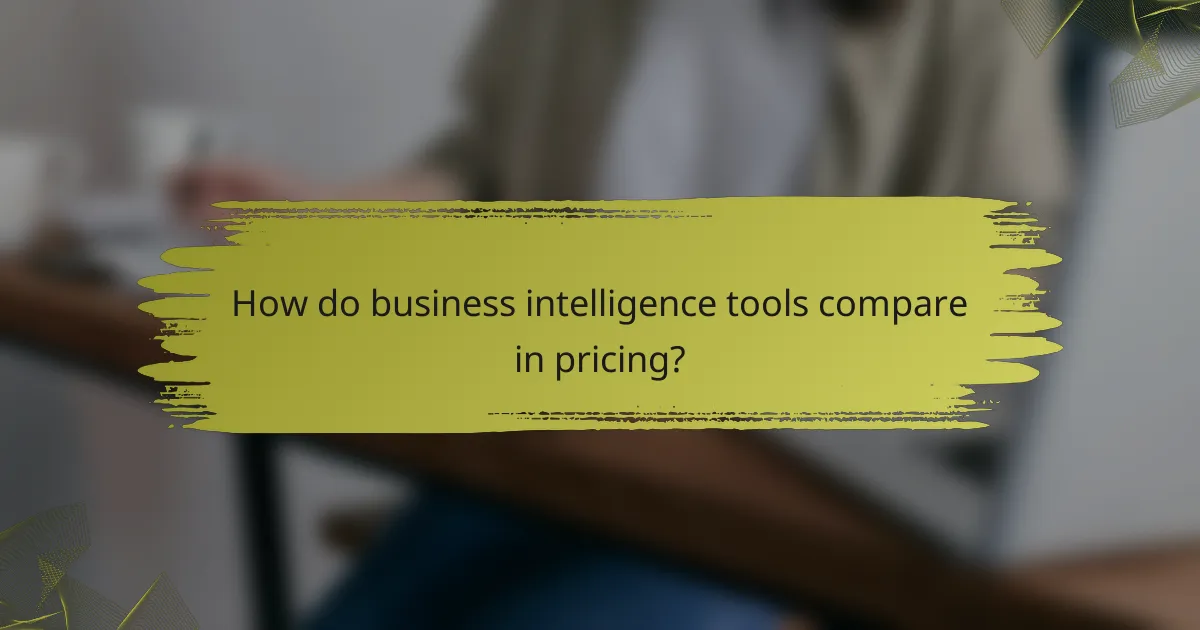Business intelligence tools play a crucial role in integrating data across various platforms, enabling organizations to derive comprehensive insights for informed decision-making. By streamlining data analysis and enhancing workflow efficiency, these tools facilitate quicker access to information, automate repetitive tasks, and improve collaboration among teams, ultimately optimizing business processes.

What are the best business intelligence tools for integration?
The best business intelligence tools for integration facilitate seamless data connection and analysis across various platforms. These tools enhance decision-making by providing comprehensive insights derived from multiple data sources.
Tableau
Tableau is renowned for its powerful data visualization capabilities and ease of integration with numerous data sources, including SQL databases, cloud services, and spreadsheets. It allows users to create interactive dashboards that can be shared across teams, enhancing collaboration.
When using Tableau, consider its licensing costs, which can vary based on user roles and features. It’s essential to evaluate whether the investment aligns with your organization’s data needs and budget.
Microsoft Power BI
Microsoft Power BI offers robust integration with other Microsoft products, making it a popular choice for businesses already using the Microsoft ecosystem. It supports a wide range of data sources and provides real-time analytics through its cloud-based platform.
Power BI is generally cost-effective, with a free version available for small teams. However, larger organizations may need to invest in the Pro or Premium versions for advanced features and greater data capacity.
Qlik Sense
Qlik Sense is known for its associative data model, which allows users to explore data freely without predefined queries. This flexibility makes it easy to integrate data from various sources and uncover hidden insights.
When implementing Qlik Sense, ensure that your team is trained in its unique interface to maximize its potential. Additionally, consider the licensing structure, which can be complex, depending on the number of users and data sources.
Looker
Looker is a modern BI tool that emphasizes data modeling and exploration, allowing users to create custom reports and dashboards. Its integration capabilities are strong, particularly with cloud databases like BigQuery and Redshift.
Looker’s pricing is typically subscription-based, and it may be more suitable for larger organizations that require extensive data analytics and collaboration features. Evaluate your data architecture to ensure compatibility with Looker’s requirements.
IBM Cognos Analytics
IBM Cognos Analytics provides comprehensive reporting and analytics features, with strong integration capabilities across various data sources. It is particularly favored by enterprises needing robust governance and security features.
While Cognos offers powerful tools, it can be complex and may require significant training for users. Organizations should assess their specific needs and the potential return on investment before committing to this platform.

How do business intelligence tools impact development?
Business intelligence tools significantly enhance development by streamlining data analysis and improving overall workflow efficiency. They enable organizations to harness data effectively, leading to informed decision-making and optimized processes.
Enhanced data visualization
Enhanced data visualization allows teams to interpret complex data sets through intuitive graphical representations. Tools like dashboards and charts transform raw data into visual formats, making it easier to identify trends and patterns.
For example, a sales team can use visualizations to track performance metrics over time, helping them quickly spot areas needing attention. Effective visualizations can reduce the time spent analyzing data by up to 50%, allowing teams to focus on strategic initiatives.
Improved decision-making
Improved decision-making is a direct benefit of utilizing business intelligence tools, as they provide actionable insights based on real-time data. With access to accurate information, teams can make informed choices that align with business objectives.
For instance, a marketing department can analyze customer behavior data to tailor campaigns effectively, leading to higher engagement rates. Organizations that leverage data-driven decision-making often see a significant increase in their operational efficiency and profitability.
Faster report generation
Faster report generation is another key advantage of business intelligence tools, which automate the process of compiling and distributing reports. This automation reduces the time required to generate reports from days to mere hours or minutes.
For example, a finance team can generate monthly performance reports automatically, freeing up resources for analysis rather than data collection. By streamlining this process, businesses can respond to market changes more swiftly and maintain a competitive edge.

What are the benefits of using business intelligence tools for workflow efficiency?
Business intelligence tools enhance workflow efficiency by providing quick access to data, automating repetitive tasks, and fostering better collaboration among teams. These tools streamline processes, allowing businesses to make informed decisions faster and with greater accuracy.
Streamlined data access
Business intelligence tools centralize data from various sources, making it easier for users to access relevant information quickly. This reduces the time spent searching for data across multiple systems and improves overall productivity.
For instance, a sales team can utilize a BI tool to pull customer data from their CRM and financial data from their accounting software in one dashboard. This integration allows for faster analysis and decision-making.
Automated reporting processes
Automating reporting processes is a key feature of business intelligence tools, which can save significant time and reduce errors. Instead of manually compiling reports, teams can set up automated schedules to generate reports at regular intervals.
For example, a marketing department may automate weekly performance reports that pull data from various campaigns, allowing them to focus on strategy rather than data collection. This can lead to quicker insights and more agile responses to market changes.
Increased collaboration among teams
Business intelligence tools facilitate collaboration by providing a shared platform for data analysis and reporting. Teams can work together more effectively, as they can access the same information and insights in real-time.
Using collaborative features, such as shared dashboards or comment sections, teams can discuss findings and strategies directly within the tool. This reduces miscommunication and helps align goals across departments, ultimately improving workflow efficiency.

What criteria should be considered when selecting a business intelligence tool?
When selecting a business intelligence tool, consider integration capabilities, user interface, and cost. These factors significantly influence how effectively the tool can be utilized within your organization and its overall impact on decision-making processes.
Integration capabilities
Integration capabilities refer to how well the business intelligence tool connects with existing systems and data sources. Look for tools that can seamlessly integrate with your current databases, CRM systems, and other software to ensure smooth data flow and accessibility.
Evaluate whether the tool supports APIs, data connectors, and pre-built integrations with popular platforms. A tool that can easily connect with multiple data sources will save time and reduce the complexity of data management.
User interface and experience
The user interface and experience are crucial for ensuring that team members can effectively use the business intelligence tool. A clean, intuitive interface allows users to navigate the system easily, reducing the learning curve and increasing adoption rates.
Consider tools that offer customizable dashboards and visualizations, enabling users to tailor their experience according to their specific needs. User feedback and usability testing can help identify which interfaces are most effective for your team.
Cost and licensing options
Cost and licensing options can vary widely among business intelligence tools, making it essential to understand your budget and the pricing structure. Look for transparent pricing models, including subscription fees, one-time costs, and any additional charges for upgrades or support.
Evaluate whether the tool offers a free trial or a tiered pricing system that allows you to scale as your business grows. This flexibility can help you manage expenses while ensuring you have the necessary features for your operations.

How do business intelligence tools compare in pricing?
Business intelligence tools vary significantly in pricing based on features, user licenses, and deployment options. Generally, costs can range from free versions with limited capabilities to several thousand dollars annually for comprehensive solutions tailored for larger organizations.
Tableau pricing structure
Tableau offers a tiered pricing structure that caters to different user needs. The primary options include Tableau Creator, Tableau Explorer, and Tableau Viewer, with prices typically starting around $70 per user per month for Creator licenses, while Explorer and Viewer licenses are priced lower.
Organizations should consider their specific requirements when selecting a Tableau plan. For instance, if a team needs extensive data analysis capabilities, investing in Creator licenses may be worthwhile. Conversely, for teams primarily consuming reports, Viewer licenses might suffice.
Additionally, Tableau provides discounts for annual subscriptions and offers a free trial, allowing potential users to evaluate the tool before committing financially. It’s advisable to assess the total cost of ownership, including potential add-ons and training, to ensure alignment with budget constraints.



